The Hunt for Beach Worms
One phrase that holds true for beach fishing is "If you find the bait, you'll find the fish". Australian beaches may appear dauntless in their seemingly endless expanse stretching away in the distance, and it can be difficult sometimes to know where to throw your line in, with any hope of a hookup.
One good indication of where to fish is, if a section of beach has a good show of bait on it, such as worms and cockles, then the odds are that the fish are in the vicinity.
The best time to look for worms is on a run-out tide. You can find them anywhere from the high tide mark, right down to the water's edge of the wave break. The further down the beach the worms are, usually the bigger they are. Also a run-out tide gives you an extra couple of seconds between each wave wash to catch them.
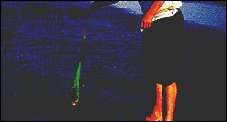 In order to catch beach worms, you need either an old sock or stocking to hold some fish in. Tie a piece of rope to it, and a loop on the other end to go around your waist. This bag of offal is to be used as berley. Next, make sure you have a berley bucket around you waist to hold all those worms you are going to catch. You will also need a small piece of tough bait. A thick piece of squid flesh is best. In order to catch beach worms, you need either an old sock or stocking to hold some fish in. Tie a piece of rope to it, and a loop on the other end to go around your waist. This bag of offal is to be used as berley. Next, make sure you have a berley bucket around you waist to hold all those worms you are going to catch. You will also need a small piece of tough bait. A thick piece of squid flesh is best.
On the run-out tide, look for a gently sloping beach of fine grade sand, preferably a place where there isn't too much activity. Go down to the top of the surf line and as the wave comes up the beach and washes around your ankles, move the offal bag from side to side in the water until the wave recedes.
As the wave returns, look carefully at the water as it disappears and you will see a "V" shaped pattern. This will be a worm poking its head out of the sand, looking for what's causing the smell.
Once you have located the worm, keep your eyes glued to the spot. The worm will disappear once the wave has gone. Walk softly to the spot, don't stomp, and place your feet either side of where the worm was. Then place the bag of offal under one foot so that it's out of the way and leaves both hands free.
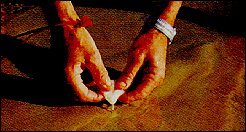 Gently place a piece of squid onto the spot where the worm was and if you haven't scared it, it will poke its head up for a look. Let the worm actually grip the squid with its mouth. Don't try to lift the worm higher out of the hole by pulling on the squid. Just watch it for a few seconds and see what it does. Gently place a piece of squid onto the spot where the worm was and if you haven't scared it, it will poke its head up for a look. Let the worm actually grip the squid with its mouth. Don't try to lift the worm higher out of the hole by pulling on the squid. Just watch it for a few seconds and see what it does.
When you're worming, you have to be quick for two reasons. Firstly, to be able to grip the worm, and secondly to do it before the next wave comes in. If a wave comes back before you are ready, just hold your ground with the berley still in the water, but not over the worm itself.
Now if you watch closely, you will see the worm hunch its back and try and pull the squid back down the hole. When you're learning, watch this process a few times before the next step, so you'll know what's going to happen.
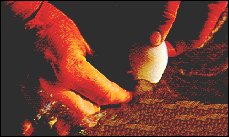 You've got the piece of squid in one hand attached to the worm. Now place your free hand down onto the sand and put your thumb and forefinger either side of the worm so that you can just feel it between your fingers. This must be done with the absolute minimum of pressure, either on the worm or the sand. Just keep your fingers there and watch and feel the worm hunching and retracting. You've got the piece of squid in one hand attached to the worm. Now place your free hand down onto the sand and put your thumb and forefinger either side of the worm so that you can just feel it between your fingers. This must be done with the absolute minimum of pressure, either on the worm or the sand. Just keep your fingers there and watch and feel the worm hunching and retracting.
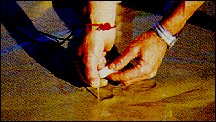 Now that was the easy part. The reason I want you to get to know how the worm feeds is because the next step is catch it or lose it. When the worm hunches its head again, as it rises up, but before it reaches the top of the hunch (when it's fully committed to the hunch), clamp your forefinger and thumb together just below its head, that is, about a centimetre below its mouth. Too early or too late, and it wont be there. This is where practice makes perfect ! Now that was the easy part. The reason I want you to get to know how the worm feeds is because the next step is catch it or lose it. When the worm hunches its head again, as it rises up, but before it reaches the top of the hunch (when it's fully committed to the hunch), clamp your forefinger and thumb together just below its head, that is, about a centimetre below its mouth. Too early or too late, and it wont be there. This is where practice makes perfect !
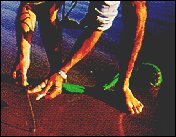 If you timed everything right, you'll have a worm between your fingers. These worms are surprisingly strong and slippery, and will try to contract back down the hole. When you've first gripped the worm, just hold it until the contraction is over, the pull gently, but firmly, straight up. If all went well, you'll have a worm dangling from your hand. If you timed everything right, you'll have a worm between your fingers. These worms are surprisingly strong and slippery, and will try to contract back down the hole. When you've first gripped the worm, just hold it until the contraction is over, the pull gently, but firmly, straight up. If all went well, you'll have a worm dangling from your hand.
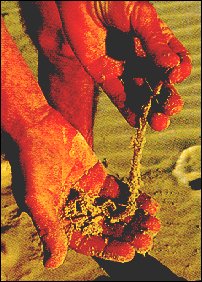
 Fishing Tip : Fishing Tip : |
|
| Why not contact fishSA.com about your Fishing Tip |
|
|